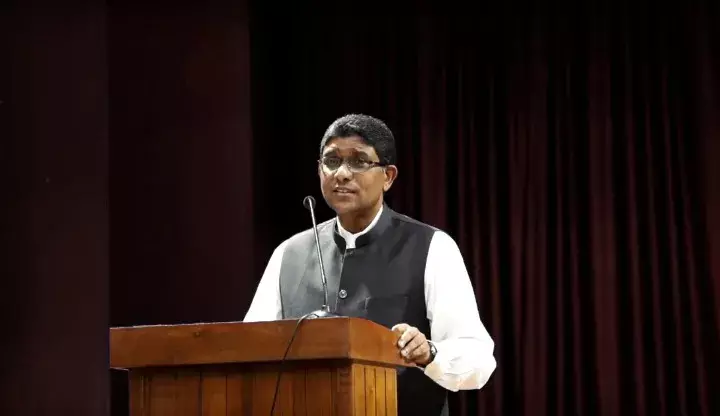Basic Structure Doctrine Militates Against Basic Scheme Of Constitution, Important To Engage In Deliberations: Justice Jayasankaran Nambiar

Speaking at an event yesterday, Kerala High Court Judge, Justice A. K. Jayasankaran Nambiar said that questions will be asked about the basic structure doctrine since it militates against the basic scheme of our Constitution.
“Why should the basic structure doctrine propounded by the judiciary be seen as freezing the Constitution in that regard for all time to come? These are questions that are normally asked and they will be asked, because it militates against the basic scheme of our Constitution”, Justice Nambiar said.
He was speaking at a lecture organised by the Ernakulam Government Law College Old Students and Teachers Association at Ernakulam on the subject- "Basic Structure Of Indian Constitution & its Present Day Challenges".
“When you are talking about the Constitution which is an organic document and change is the only constant, this concept of having an implied limitation on that change sounds a little bit of a misfit”, he said referring to the basic structure doctrine that limits the power of the parliament to amend the Constitution.
Justice Nambiar said that Constitution is an evolving document and it can never be static. He said that it is a governing document which governs the society and people, and as long as you have a change in the society and the attitude of people, we will have Constitution fall in sync will those changing attitudes. He said that interpretation of the Constitution has to be dynamic.
Justice Jayasankaran Nambiar said that Part 3 of the Constitution is restricted to only a few rights for the reason that the Constituent Assembly was not meant to solve all the problems faced by society in those days. He said that the issues which could not be resolved were put in Part 4 of the Constitution.
“You have to see how the society develops, what are the changing attitudes of the society. What is good today may be bad tomorrow. So, let’s not freeze the Constitution for all time to come. Because that would be, like the Americans say, the dead hand of the past governing the future. We don’t want that. You need a Constitution that will always remain as a governing document and remain relevant as a governing document. So you need to confine what you are freezing to the bare minimum. Because if you do more than that you are actually controlling the Constitution, you are preventing it from evolving”, he said.
“What is apparent from a joint reading of Part 3, Part 4 and Article 368, there is an inbuilt scheme of incremental empowerment of the citizenry. This is important because you need to understand that the Constitution was never meant to be static even at the time of its inception or adoption. The framers deliberately put in a clause Article 368 for its amendment, Part 3 and Part 4 providing for an ‘incremental empowerment’. It is not something to be achieved overnight. Even your fundamental rights”, he said.
He said that when we are talking about a scheme of incremental empowerment, the question that will naturally be asked is about the scope of the provision for limitations of the power to amend.
“Against the backdrop of a scheme of incremental empowerment of the citizenry which is inbuilt in our Constitution, against the scheme of change that is inbuilt in our Constitution, how do you explain an implied limitation? There are express provisions in the Constitution which limit- Article 13(2). It says that you shall not abridge or take away only those rights in Part 3. What about the other provisions outside of Part 3? Are they to be taken away, are they to be abridged? If they are, who is to say so?”, Justice Nambiar asked.
He said that if a document is supposed to be frozen at a point in time, it will never provide a clause for its amendment. “Therefore the amendment provision itself signals the need for a change or the idea that it should be changed in future times”, he said adding that the provision for amendment is not surprising because ours is a transformative Constitution.
He also said that the Constitution must be interpreted as a social document rather than a legal document.
In January this year, Vice-President Jagdeep Dhankhar had said that the Kesavananda Bharati judgment of 1973, which enunciated the principle of basic structure of the Constitution, set a bad precedent.
He had said that “in a democratic society, the basis of any basic structure has to be the supremacy of the mandate of people. Sovereignty of people, sovereignty of the parliament, executive thrives on sovereignty of the parliament. Legislature and parliament decide who will be the chief minister or prime minister. The ultimate power is with the legislature. In such a situation, all constitutional institutions, the legislature, the executive, the parliament are required to be within their limits and confirm to the highest standard of propriety and decorum.”
While dismissing a PIL against Vice President Jagdeep Dhankar over his said remarks against the basic structure doctrine, the Bombay High Court observed that fair criticism of a judgment is permissible.
Subsequently, Chief Justice D Y Chandrachud called the basic structure doctrine a "North Star" that guides and gives certain direction to the interpreters and implementers of the Constitution when the path ahead is convoluted, while delivering a lecture in Mumbai.

